Having a pool in Texas is a dream for many, and the right landscaping can take your pool area to the next level. But with the scorching Texas sun and unique climate, it’s important to choose the right plants that can thrive in this environment.
Here are the best plants to put around a pool in Texas or anywhere around the world:
- Agave Americana: A drought-tolerant succulent with striking rosette-shaped leaves.
- Texas Olive: A small evergreen tree with glossy leaves and fragrant white flowers.
- Yucca: A desert plant known for its sword-like leaves and tall flower spikes.
- Lantana: A vibrant, low-maintenance flowering shrub that attracts butterflies.
- Trailing Rosemary: An aromatic herb that cascades over walls or containers, adding beauty and fragrance.
These plants are well-suited for the Texas climate and can withstand the heat and humidity often experienced around pools. Remember to provide adequate irrigation and regular pruning to maintain their health and appearance.
In this blog post, we will explore some of the best plants to put around a pool in Texas based on factual data, so you can create a beautiful and low-maintenance oasis in your backyard. From succulents to palm trees, we have got you covered. So, let’s dive in and discover the perfect poolside plants for your Texas paradise.
What Are the Best Plants to Put Around the Pool in Texas?
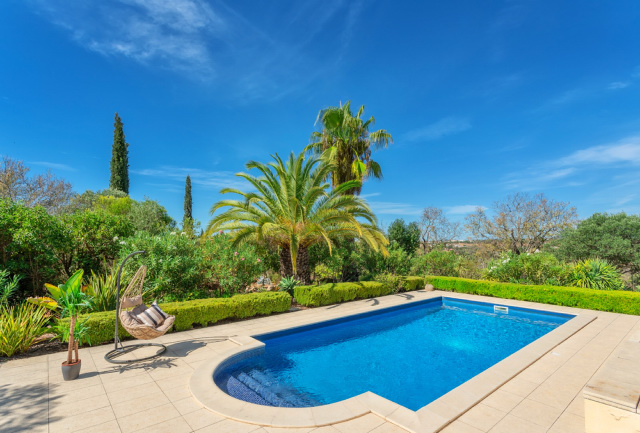
Agave
Agave characteristics and benefits
Agave plants are a popular choice for landscaping around pools in Texas due to their hardiness and low maintenance requirements. They are known for their spiky leaves and unique rosette shape. One of the main benefits of agave plants is their ability to withstand hot and dry conditions, making them ideal for the Texas climate. They also come in various sizes and colors, allowing for versatility in design.
Best placement and care tips for Agave plants
When planting agave around your pool in Texas, choosing a location that receives plenty of sunlight is important. These plants thrive in well-draining soil and should be watered sparingly, as over-watering can lead to root rot. Agave plants have low water needs and can tolerate drought conditions, making them an excellent choice for poolside landscaping. Additionally, they require minimal pruning or maintenance, making them an easy and hassle-free option.
Recap of key points:
- Agave plants are hardy and low maintenance.
- They can withstand hot and dry conditions.
- Agaves come in various sizes and colors.
- They should be placed in a sunny location with well-draining soil.
- Water sparingly to avoid root rot.
- Agaves require minimal pruning or maintenance.
:max_bytes(150000):strip_icc()/GettyImages-560405655-56c26c545f9b5829f8680f45.jpg)
Bird of Paradise
Bird of Paradise features and advantages
- The Bird of Paradise plant, also known as Strelitzia Reginae, is a stunning tropical plant that can add a touch of exotic beauty to your poolside landscaping.
- It features vibrant orange and blue flowers that resemble the shape of a bird’s beak and feathers, hence its name.
- The long-lasting blooms can attract birds and butterflies, adding liveliness to your outdoor space.
- The plant has large, banana-like leaves that create a bold and dramatic statement.
Suitable locations and maintenance tips for Bird of Paradise plants
- The Bird of Paradise thrives in full sun to partial shade, making it ideal for Texas’s warm climate.
- It requires well-draining soil and plenty of water during the growing season but should be protected from overwatering during winter.
- This plant is suitable for poolside planting as it can tolerate chlorine exposure and high humidity.
- Regular pruning is essential to maintain its attractive appearance. Remove old or damaged leaves and spent flower stalks to encourage new growth.
Recap:
| Plant Name | Bird of Paradise |
|---|---|
| Features | Vibrant orange and blue bird-like flowers, large banana-like leaves |
| Advantages | Adds exotic beauty, attracts birds and butterflies |
| Suitable locations | Full sun to partial shade, poolside planting |
| Maintenance tips | Well-draining soil, regular watering, pruning |
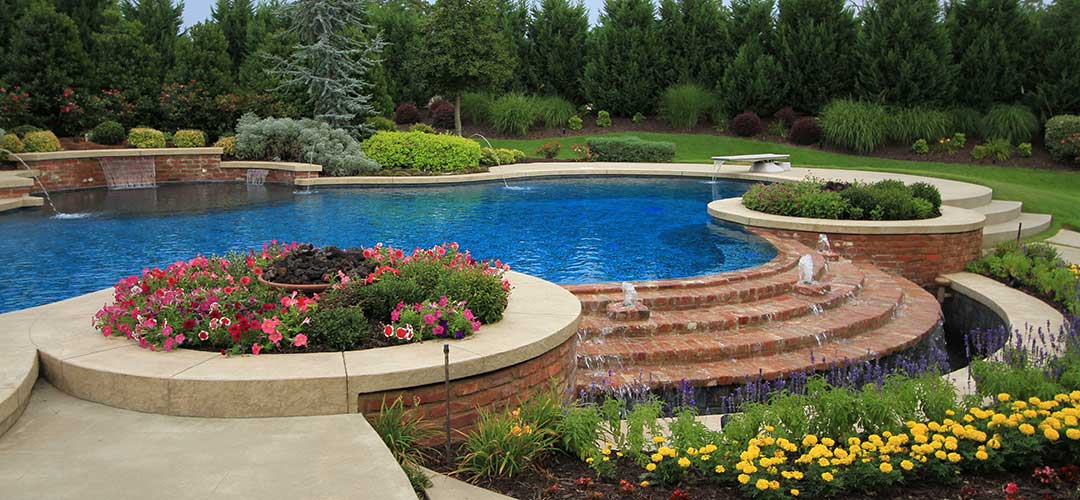
Lantana
Lantana plant overview
Lantana is a popular choice for landscaping around pools in Texas due to its vibrant colors and ability to attract butterflies. It is a perennial plant that thrives in hot climates and is known for its drought tolerance. Lantana blooms from spring to fall, producing clusters of small flowers in various shades of red, orange, yellow, and purple. It can grow up to 2-3 feet tall and wide, making it a great option for borders or as a ground cover.
Ideal placement and care instructions for Lantana around a pool
Lantana should be planted in a sunny location with well-drained soil. Giving the plant enough space to spread out and provide proper air circulation is important. When planting around a pool, consider placing it in the back or sides of the pool area to prevent falling leaves or debris from littering the water.
To care for Lantana, water it regularly during dry periods, especially in the summer heat. However, be cautious not to overwater as it can lead to root rot. Pruning is also recommended to promote bushier growth and remove dead or damaged branches. Adding a layer of mulch around the base of the plant will help retain moisture and suppress weed growth.
Overall, Lantana is a beautiful and low-maintenance plant that can add color and charm to your poolside landscaping in Texas.
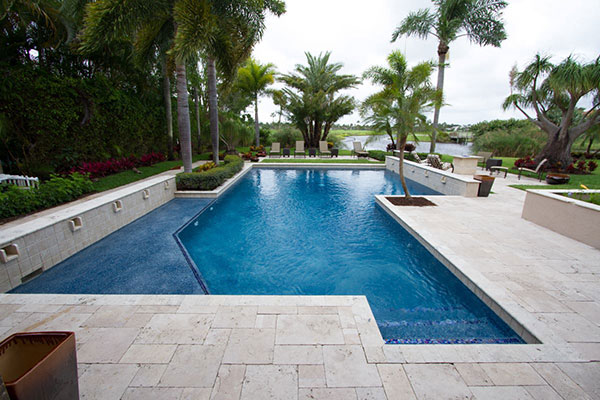
Palms
Different varieties of palms for poolside landscaping
- Windmill Palm: Known for its cold hardiness and elegant, fan-shaped leaves. It adds a tropical touch to your pool area.
- Pygmy Date Palm: With its compact size and feathery leaves, this palm is perfect for smaller pool areas.
- Queen Palm: A popular choice for larger pool areas, this palm features graceful fronds and can tolerate various soil conditions.
Tips for planting and maintaining palm trees near a pool
- Choose the right spot: Consider the sunlight and space requirements of the palm before planting it near your pool. Also, leave enough distance from the pool to prevent falling leaves and debris.
- Provide proper drainage: Palms require well-drained soil to thrive. Ensure the area around the pool has good drainage and does not retain water.
- Regular pruning: Trim dead or damaged fronds to keep your palms looking tidy and prevent them from interfering with pool equipment or pathways.
In conclusion, adding palms around your Texas pool can create a lush and tropical atmosphere. With careful selection, planting, and maintenance, you can enjoy the beauty and benefits of these stunning trees while enhancing your poolside landscaping.
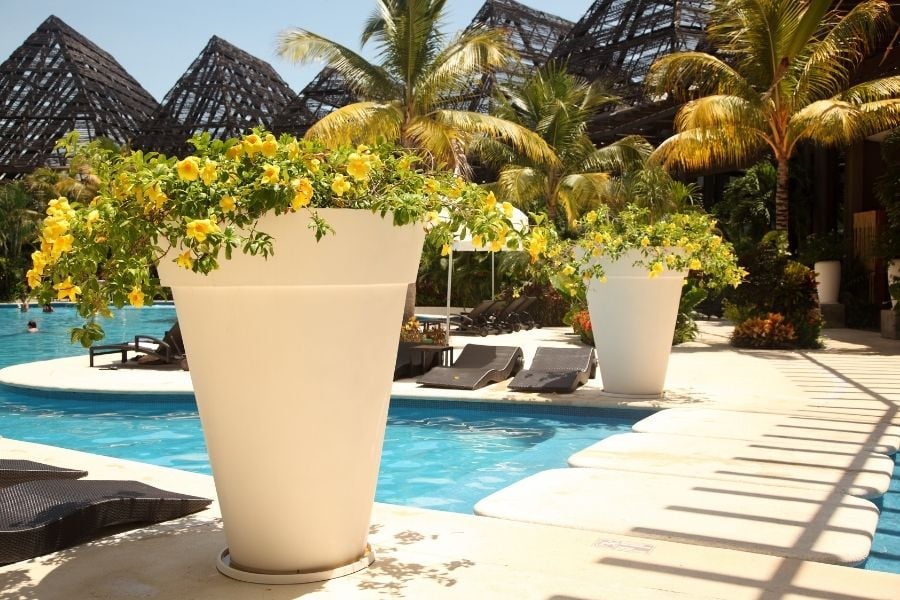
Check out the latest article on Palm Trees Survival,
Hibiscus
Hibiscus plant information and benefits
The hibiscus plant is popular for poolside landscaping in Texas due to its vibrant and eye-catching flowers. This tropical plant comes in various colors, including red, pink, yellow, and white, adding a touch of beauty to your pool area. Additionally, hibiscus plants are known for attracting butterflies and hummingbirds, enhancing the overall ambiance of your outdoor space.
Proper positioning and care guidelines for Hibiscus plants around a pool
When placing hibiscus plants around your pool, it is important to consider their sunlight and water requirements. Hibiscus thrives in full sun, so position them in an area that receives at least six hours of direct sunlight daily. Additionally, they require regular watering to keep the soil moist but not soggy.
To ensure the health and longevity of your hibiscus plants, it is essential to provide proper care. This includes regular pruning, fertilizing with a balanced fertilizer during the growing season, and protecting them from frost during winter.
Overall, hibiscus plants are a fantastic choice for adding beauty and color to your poolside landscape in Texas. With proper positioning and care, these plants will thrive and create a vibrant oasis around your pool.

Bougainvillea
Bougainvillea plant characteristics and advantages
- Bougainvillea is a beautiful flowering plant that adds vibrant colors to your poolside landscape.
- It is known for its stunning, papery bracts in various shades of pink, purple, red, and orange.
- Bougainvillea is a low-maintenance plant that thrives in the hot and sunny climate of Texas.
- The drought-tolerant plant can withstand the heat, perfecting poolside landscaping.
Best practices for planting and nurturing Bougainvillea near a pool
- Choose a spot that receives full sun for at least six hours daily.
- Ensure proper drainage to prevent waterlogged soil, which can cause root rot.
- Provide support such as a trellis or fence for the climbing varieties.
- Water regularly, but avoid overwatering as it can lead to root rot.
- Prune regularly to control growth and maintain shape.
Bougainvillea is an excellent choice for poolside landscaping in Texas. It’s vibrant colors and low maintenance make it a perfect addition to enhance the beauty and appeal of your outdoor space. Bougainvillea will thrive and bring joy to your pool area with proper care.
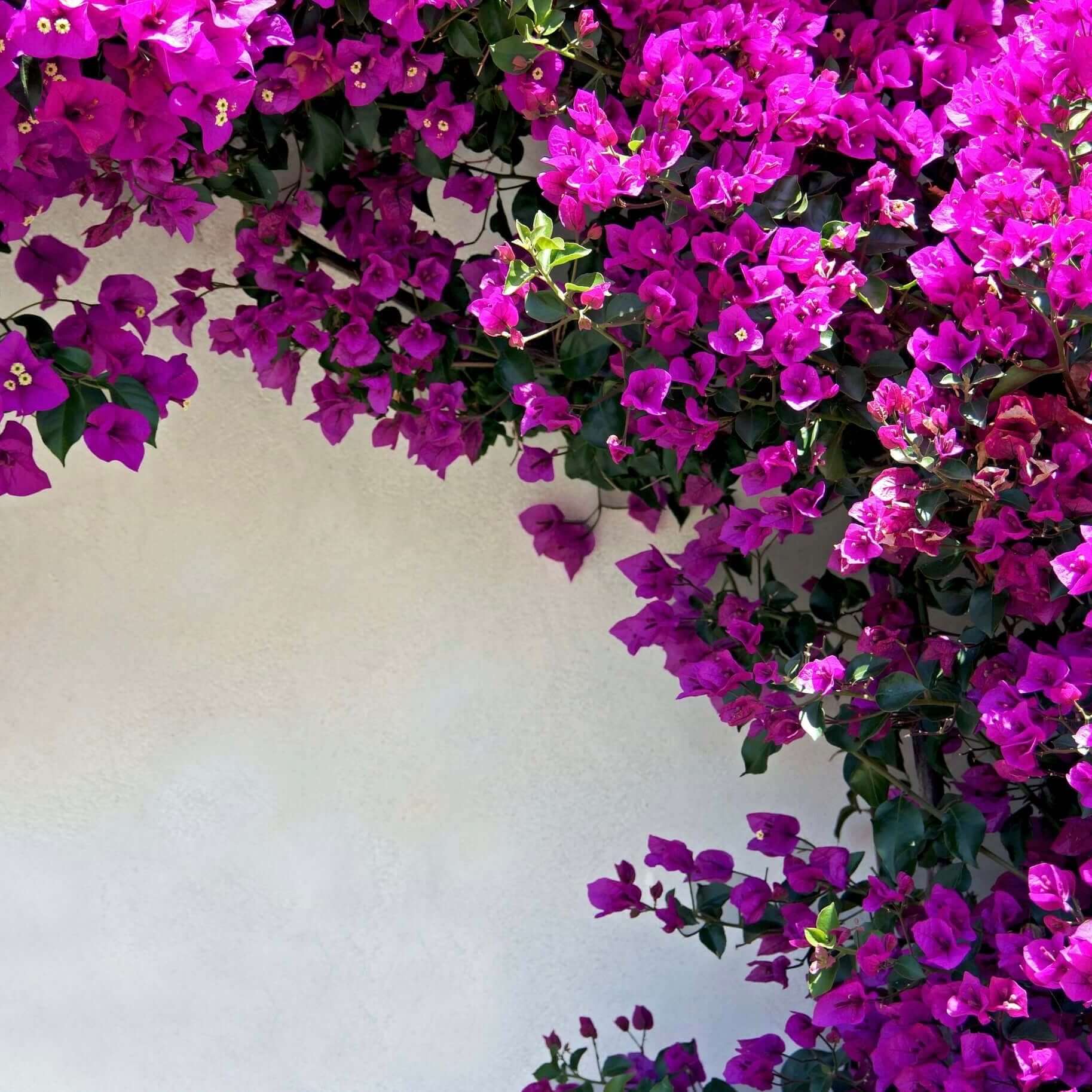
Source: plantsexpress.com
Yucca
Yucca plant overview
The Yucca plant is popular for poolside landscaping in Texas because it can withstand hot and dry conditions. It is a type of succulent that features long, sword-like leaves and produces tall, spike-like blooms. This plant is aesthetically pleasing and low-maintenance, making it perfect for pool areas.
Recommended locations and care instructions for Yucca plants around a pool
- Sun Exposure: Yucca plants thrive in full sun exposure, so be sure to place them in areas that receive at least six hours of direct sunlight.
- Drainage: Yuccas require well-drained soil to prevent root rot. Make sure the area around your pool has good drainage.
- Watering: Yuccas are drought-tolerant and only need watering once every two weeks or when the soil feels dry.
- Pruning: Remove dead or damaged leaves from the bottom of the plant regularly to maintain their appearance.
- Pests and Diseases: Yucca plants are generally resistant to pests and diseases.
By incorporating Yucca plants into your poolside landscaping in Texas, you can add beauty and interest while requiring minimal maintenance. The resilience of this plant makes it a suitable choice for the hot and dry climate of Texas.

Mexican Heather
Introduction to Mexican Heather plants
Mexican Heather, also known as Cuphea hyssopifolia, is a beautiful plant that thrives in the Texas heat. Its delicate purple flowers and fine, lacy foliage add color and texture to any poolside landscape. It is a low-maintenance plant that requires very little water once established.
Tips for planting and maintaining Mexican Heather around a pool
- Plant in well-drained soil: Mexican Heather prefers well-drained soil to prevent root rot.
- Provide enough sunlight: These plants thrive in full sun to partial shade, so choose a spot with adequate sunlight.
- Water regularly: While drought tolerant, Mexican Heather plants still require regular watering to keep them healthy and blooming.
- Prune regularly: To maintain a neat appearance, regularly prune your Mexican Heather plant to remove dead or damaged branches.
- Fertilize occasionally: It’s recommended to fertilize Mexican Heather plants every few months with a balanced fertilizer.
Mexican Heather is a perfect choice for planting around pools in Texas due to its adaptability to the hot climate and its vibrant purple blooms. Its low-maintenance nature makes it an excellent addition to any poolside landscaping project.
What Should I Landscape Around My Pool?
If you have a pool, you know that the area around it needs to be carefully planned out. The last thing you want is for your pool to be an eyesore in your backyard!
Here are some tips on what to landscape around your pool:
- Use native plants. This will help save you money on watering and maintenance costs. Plus, they’ll be more tolerant of the heat and sun they’ll be exposed to near the pool.
- Consider low-maintenance options. No one wants to spend all their time maintaining their landscaping! Choose materials and plants that won’t require much work to keep looking good.
- Incorporate water features. Water features can add both beauty and relaxation to your backyard oasis. Consider adding a waterfall or fountain near your pool for a stunning effect.
- Add some privacy. If you’re worried about people being able to see into your backyard, consider adding some privacy screens or planting tall bushes along your property’s perimeter.
What Should You Not Plant Near a Pool?
When planning a garden near a pool, it is essential to consider what plants will be safe to grow in the area. Many plants can release toxins into the water, which can harm swimmers. Some plants also have sharp leaves or thorns that could hurt swimmers if they brushed up against them.
Here is a list of plants to avoid growing near a pool:
- Oleander ( Nerium oleander)
- Castor bean ( Ricinus communis)
- Daffodil ( Narcissus sp.)
- Rhubarb ( Rheum sp.)
- Foxglove ( Digitalis sp.)
These are just a few examples, so be sure to do your research before planting anything near your pool!
Best Plants to Put Around a Pool in Dallas
If you’re looking for the best plants to put around your pool in Dallas, you’ve come to the right place! There are a few things to consider when choosing plants for this area, such as heat and humidity tolerance, water needs, and whether or not they’ll attract bees and other insects. With that in mind,
Here are our top picks for the best plants to put around your pool in Dallas:
- Yarrow (Achillea millefolium) – A hardy perennial tolerant of heat and humidity, yarrow is an excellent choice for planting around pools in Dallas. It has beautiful flowers that come in various colors, including white, pink, yellow, and red. Yarrow is also relatively drought-tolerant once it’s established, making it a low-maintenance option for busy pool owners.
- Crepe Myrtle (Lagerstroemia indica) – Another heat- and humidity-tolerant plant that does well in Dallas is crepe myrtle. This deciduous shrub or small tree produces beautiful flowers in shades of pink, purple, red, or white from late spring through early fall. And like yarrow, crepe myrtle is relatively drought-tolerant once established.
- Lantana (Lantana camara) – A popular choice for planting around pools due to its heat tolerance and colorful flowers, lantana comes in many different varieties that bloom throughout the summer months. While lantana requires regular watering to stay healthy during hot weather, it’s generally low-maintenance overall. Just be sure to deadhead spent blooms regularly to encourage continued flowering!
- Hibiscus (Hibiscus rosa-sinensis) – another tropical plant that does well in the Dallas climate conditions near pools is hibiscus. This large shrub or small tree produces gorgeous trumpet-shaped flowers in red, pink, orange, yellow, or white shades. Hibiscus requires regular watering during hot weather but is otherwise relatively easy to care for.
- Pentas ( Pentas lanceolata ) – if you’re looking for a plant with showy flowers that attract hummingbirds, pentas is a great option!
Best Plants for Inside Pool Enclosure
If you’re lucky enough to have a pool, you know how great it is to be able to take a dip whenever you want. But if your pool is outdoors, that also means dealing with all the elements – including bugs. An easy way to keep insects out of your pool (and your home) is to enclose it in a screen room.
This gives you the best of both worlds – enjoying your pool without worrying about pesky critters. However, there are a few things to consider when choosing plants for your screen room. First, because the space will be enclosed, you’ll want to ensure any plants you choose can tolerate high humidity.
Second, since less sunlight will come in, you’ll need to pick plants that don’t require full sun exposure. Here are some of our favorite options:
- Snake Plant: This hardy plant can tolerate almost anything, including low light and high humidity. It’s also known for being virtually indestructible – perfect if you have kids or pets who might accidentally knock it over.
- Boston Fern: Another plant that does well in humid environments, Boston ferns add a touch of elegance to any space. They do require more care than some other options on this list – regular watering and misting will help keep them healthy – but they’re worth the effort.
- Spider Plant: One of the most popular houseplants around, spider plants are practically impossible to kill (which makes them ideal for those with black thumbs). They thrive in indirect sunlight and benefit from being placed near a window where they can get filtered light throughout the day.
- Philodendron: If you’re looking for a vining plant to add some greenery around the perimeter of your screen room, philodendrons are a great option.
FAQ (Frequently Asked Questions):
How often should I water the plants around my pool in Texas?
Watering these plants deeply once or twice a week is recommended, allowing the soil to dry out between waterings.
Will these plants attract pests around my pool?
No plant is entirely immune to pests, but these recommended plants are generally resistant to common poolside pests. Regular inspection and treatment can help prevent any issues that may arise.
Conclusion
Choosing the right plants to surround your pool in Texas is essential for creating a beautiful and functional outdoor space. By considering factors such as the climate, maintenance requirements, and landscaping goals, you can select plants that will thrive and enhance the aesthetics of your pool area.
So whether you’re a seasoned gardener or just getting started, we hope you find these plants as helpful as we do.
Related Topics:
Insect Invasion: Threat to Utah’s Fir Forests
 Dr Ahsanur Rahman, PHD
Dr Ahsanur Rahman, PHD
UK Forests Collapse Imminent: Act Now Against Climate!
 Dr Ahsanur Rahman, PHD
Dr Ahsanur Rahman, PHD
Lightning Strikes Threat: Boreal Fires Jeopardize Carbon
 Dr Ahsanur Rahman, PHD
Dr Ahsanur Rahman, PHD






